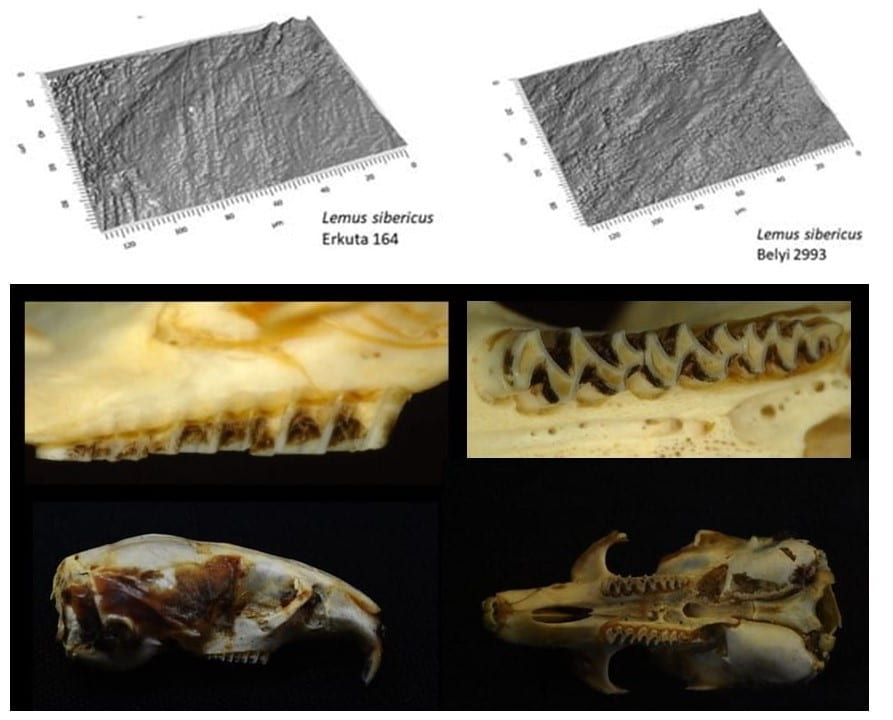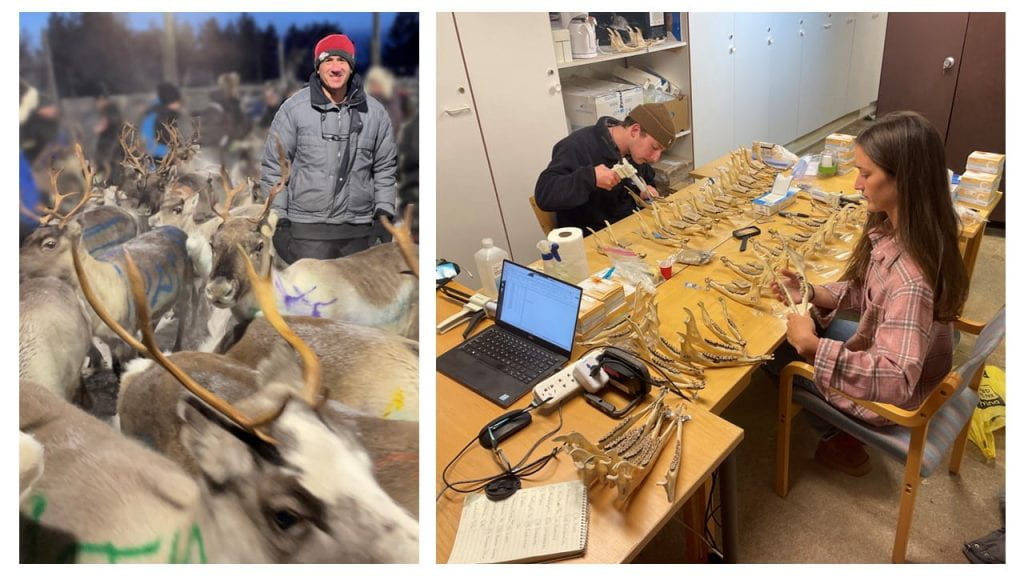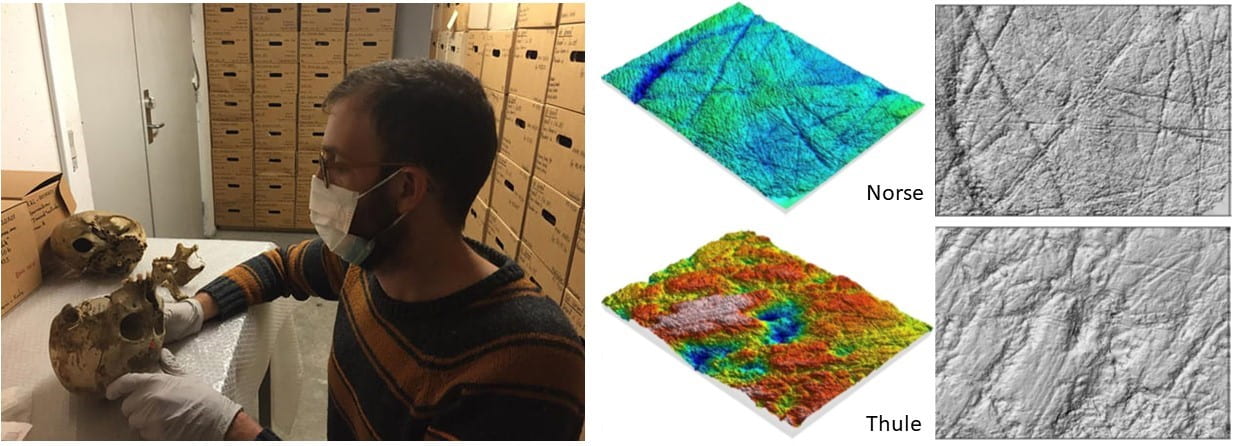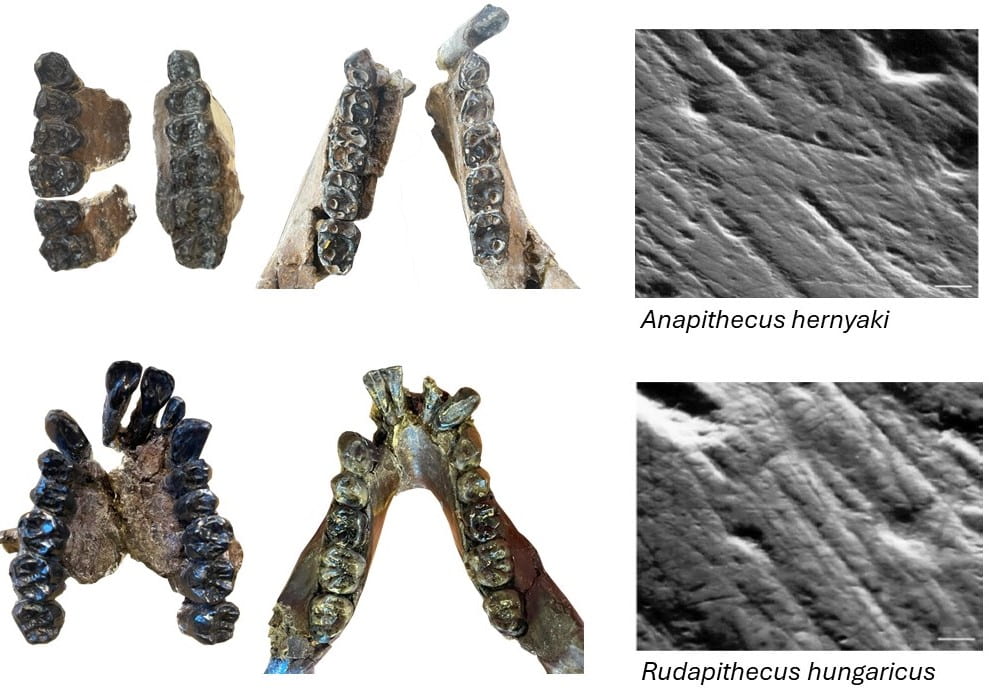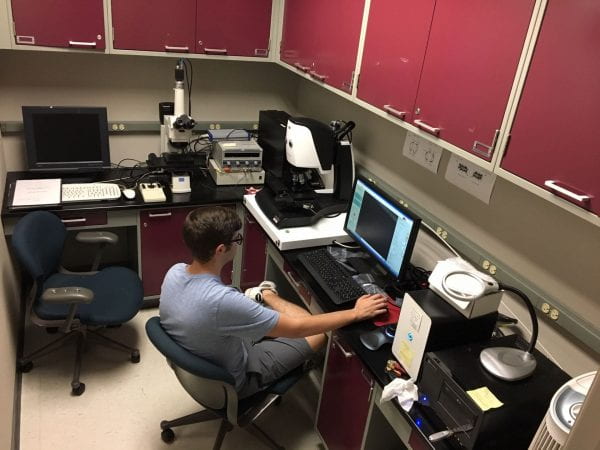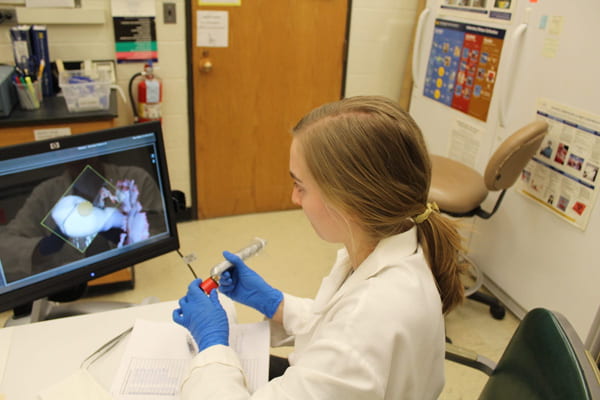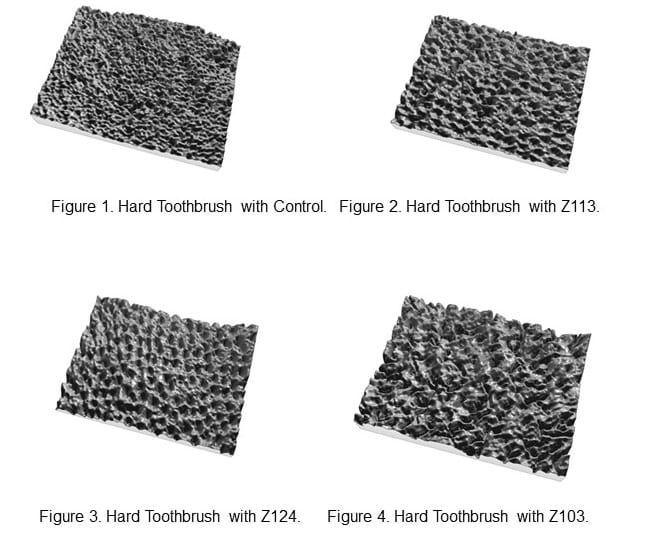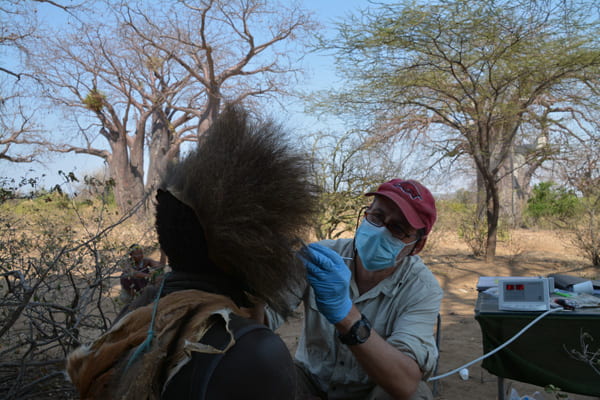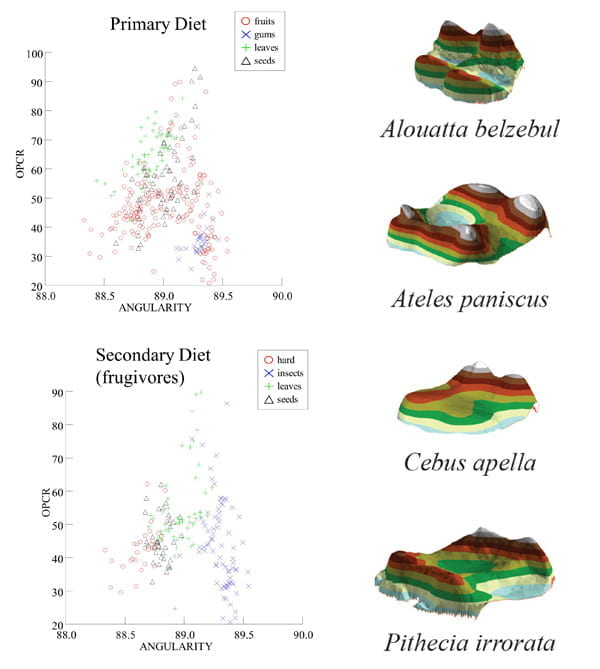Research
The Ungar Lab is involved in many projects at any given time. Explore our different research pages to learn more about what is happening in the lab.
Arctic research
Interactions of natural and social systems with climate change, globalization, and infrastructure development in the Arctic
Team Members: Peter Ungar, Valeriy Ivanov, John Ziker, Mary Heskel, Dorothee Ehrich, Desheng Liu, Aleksey Sheshukov, Jingfeng Wang, Olivier Gilg, Matt Sponheimer, Marc Macias Fauria, Gerardo Celis, Karl Mertens, Wenbo Zhou
Funding Source: US National Science Foundation
This project brings together earth system scientists, engineers, ecologists, and anthropologists to document and explain changes in ecosystems and their effects on the plants, animals, indigenous peoples, and the built environment of the Arctic. It emphasizes interactions between these elements to help understand, inform, and plan for changes to come. We focus on the Varanger Peninsula of Finnmark, Norway and northern Lapland, Finland. Varanger has all the elements needed for such a study, low and higher altitude tundra, boreal forest fringe, a rich diversity of plant and animal species, a large population of traditional peoples, and economically critical energy producing infrastructure. Lapland offers an exceptional opportunity to study reindeer herding practices and culture in a boreal forest setting. Local stakeholders will be engaged throughout the project.
This project is important because the Varanger Peninsula serves as a small-scale and manageable model for Arctic ecosystems, wherein changes in climate and their effects on temperature, precipitation, landform, plants, animals, peoples, and infrastructure need to be understood and related to one another. This work contributes to curriculum development for collaborative, transdisciplinary online inter-institutional undergraduate and graduate courses to train the next generation of scientists to take a holistic approach to problem solving.
Dental wear of small herbivores as a proxy for habitat in the Arctic
Team Members: Peter Ungar, Lindsay Saylor, Kaitlyn Puyear, Jacob Purifroy, Olivier Gilg, Alexander Sokolov, Natalya Sokolova, Sophie Montuire, Aurelien Royer, Ivan Fufachev,
Pearson Hafer
Funding Source: University of Arkansas Honors College
This project is considering variation in incisor microwear textures and cheek tooth shape/gross wear patterns of lemmings and voles along a north-south gradient in the Yamalo-Nenets Autonomous Okrug, Siberia. The Yamal Peninsula and adjacent Belyi Island represents a series of ecological zones and microhabitats that might be distinguished by wear pattern. We hope to develop a proxy by which we can reconstruct habitat in the past, gauge environmental variation today, and monitor effects of climate change into the future.
Dental wear and breakage of arctic fox teeth as indicators of dietary stress given climate variation and anthropogenic disturbance of habitats
Team Members: Peter Ungar, Blaire Van Valkenburgh, Alexandria Peterson, Aleksandr Sokolov, Natalia Sokolova, Dorothee Ehrich, Ivan Fufachev, Alexandra Terekhina, Alexander Volkovitskiy, and Viktor Shtro, Olivier Gilg, Ester Rut Unnsteinsdóttir, Eli Geffen, John Hopkins, Karsten Phillips.
This project considers gross tooth wear and patterns of antemortem fracture of the dentitions of Arctic foxes in Iceland and the Yamal Peninsula of Siberia and microwear of Yamal foxes as proxies for dietary variation associated with varying food availability across time and space. We are developing a new proxy by which we can assess impacts of climate oscillation, habitat, and anthropogenic disturbance on diets of arctic foxes.
Impacts of climate, habitat, and herding practice on diet and dental wear of reindeer in the Arctic
Team Members: Peter Ungar, Bruce Forbes, Mikael Fortelius, Ilpo Kojola, Jouko Kumpula, Kirsi Muuttoranta, Alexandra Terekhina, Alexander Volkovitskiy
Funding Source: Fulbright Foundation, Finland, University of Arkansas Honors College
This project considers gross dental wear and microwear of reindeer living in different habitats, from the boreal forests of Lapland to the tundra of Siberia, We are studying impacts of vegetation and lichen biomass in different herding areas as well as impacts of extreme weather events and supplemental feeding. The idea is to develop a new proxy for assessing dental health, diet, and nutritional stress of Arctic ungulates under different conditions.
Paleontology and bioarchaeology
Dental microwear of fossil mammals from the late Oligocene through early Pliocene of the Turkana Basin, Kenya
Team Members: Leah Fehringer, Peter Ungar, Members of the Turkana Miocene Project
Funding Source: US National Science Foundation
This project is part of the larger Turkana Miocene Project (TMP), coordinated through Stony Brook University. More information about the TMP can be found here.
The principal goal of the project is to document relationships between abiotic and biotic elements of the basin over deep time to better understand the evolution of mammalian communities over the course of the Miocene Epoch. Our part of this work involves dental microwear analysis of fossil mammals recovered from the sites of Topernawi, Buluk, Loperot, Locherangan, Lothagam, and Napudet. Our goal is to contribute to a better understanding of mammalian paleocommunity ecology in the Turkana basin from the late Oligocene to the early Pliocene; particularly regarding food choice in the context of deep time environmental change. Most work to date has focused on the primates from these sites, but we’re working on other herbivorous mammals too, from hyracoids to ruminants and pigs rodents.

Anterior tooth use in Plio-Pleistocene hominins
Team Members: Lucas Delezene, Fred Grine, Peter Ungar, Mark Teaford, Paramita Choudhury
Funding Source: LSB Leakey Foundation
Our research group has focused largely on using molar microwear to infer the diets of the early hominin, and we have published this work widely over the past decades. Much less work has been conducted on anterior dental microwear, despite differences in the sizes and shapes of the front teeth and retrodicted differences in incisor and canine use between individual species in eastern and southern Africa during the Plio-Pleistocene. This ongoing work uses dental microwear texture analysis to infer diet-related canine use in Plio-Pleistocene hominins. Our goal is to compare hominin microwear with that of extant anthropoid primates that use their canines for a variety of ingestive behaviors.
Microwear of Norse and Thule inhabitants of Greenland
Team Members:
Naseer Nassem, Peter Ungar, Lucas Delezene
Funding Source LSB Leakey Foundation
The fate of Greenland’s Viking settlements remains a topic of intense debate among archaeologists and historians. Why did they disappear whereas the Thule survived and thrived to become today’s Greenlandic Inuit? We are comparing dental microwear patterns on the molar teeth of early Viking and Thule settlers at sites from around Greenland. The goal is to determine whether there were differences over time and space, both within and between groups, in diet that might contribute to the discussion.

Dental microwear of Eocene and Oligocene primates and hyracoids from the Fayum Depression, Egypt.
Team Members:
Peter Ungar, Erik Seiffert, Steven Heritage, Matt Borths, Lindsey Lowe, Hannah Carrisalez
Funding Source LSB Leakey Foundation
The transition from the Eocene “hot house” to the Oligocene “ice box” was marked by dramatic global climate change that is believed to have led to major restructuring of mammalian communities. This project involves a dental microwear analysis of fossil primates and hyracoids from the Fayum that lived before (~37 mya), during (~34 mya), and after (~30 mya) the transition to infer diets to help us understand responses of these mammals to the intense climate change occurring at the time. And what a remarkable time it was for mammalian evolution. Fayum hyraxes were up to 1,300 kg (living ones are about 2 kg), and higher (anthropoid) primates during the Eocene were as small as 275 g during the late Eocene!
Dental microwear of Miocene primates from Rudabánya, Hungary.
Team Members:
Peter Ungar, Katie Wilcox
Funding Source University of Arkansas Honors College
Today Rudabánya is a small town in the Carpathian basin of Northern Hungary. But ten million years ago, it was a sub-tropical swamp forest on the north shore of the great Pannonian Sea. At least two species of primate, a primitive stem taxon called Anapithecus hernyaki and the great ape, Rudapithecus hungaricus, have been found at the site, along with the fossil remains of many other animals. This project aims at using dental microwear to better understand how these primates made use of the forest at Rudabánya to earn a living. This project is part of a new effort to better understand paleoecology of higher primates from Miocene of Europe and Anatolia with David Begun and Thalia Burden of the University of Toronto.

Dental microwear of Pleistocene hominids from mainland southern Asia.
Team Members:
Yaobin Fan, Leah Fehringer, Wei Wang, and Peter Ungar
Funding Source China Scholarship Council
Orangutans are the only great apes in Asia today, and they are limited to small, relict island populations on Sumatra and Borneo. During the Pleistocene, however, fossil orangutans and their relatives were much more widely distributed, from southern China through mainland Southeast Asia. How did they adapt to changing climates and habitats of the Pleistocene and pressures from humans and our ancestors? How does this translate to the exirptation of great apes from the mainland? And can this information help us with conservation efforts today? We are beginning to address these questions with the reconstruction of diets of Neogene hominids from southern China using dental microwear texture analysis in this collaboration between the Ungar Lab and the Institute of Cultural Heritage at Shandon, University.
Dental microwear analysis development
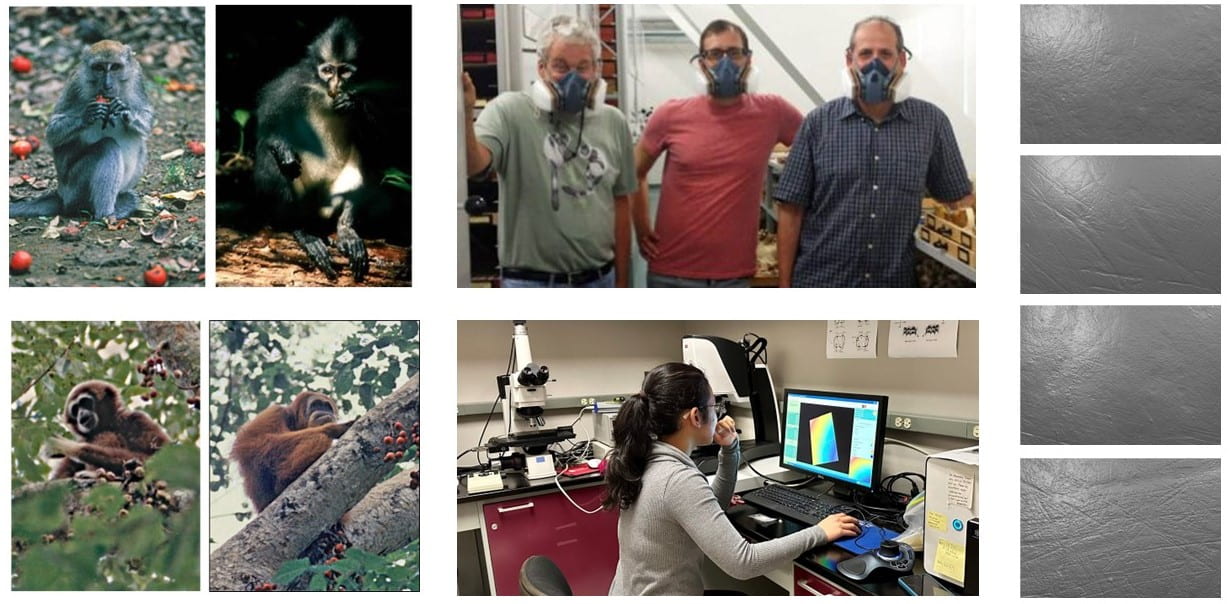
Comparative study of anterior dental microwear textures in primates
Team Members: Putu Pujantari, Lucas Delezene, Peter S. Ungar, Mark Teaford, Mike Plavcan
Funding Source: LSB Leakey Foundation
Most studies of dental microwear texture focus on molar teeth. This project aims to assess whether different patterns of ingestive behavior leave distinguishable and distinctive patterns of microscopic scratches and pits in incisors and canines of extant primates. The ultimate goal is to establish a comparative baseline series matching anterior dental microwear patterns with behaviors that can be used to interpret patterns seen in fossil teeth of early hominins and other extinct primates.
Dental topographic analysis development

Dental topographic analysis of South African galagos
Team Members: Michelle Sauther, Frank Cuozzo, Almudena Estalrrich, Putu Pujantari, Peter Ungar
Funding: US National Science Foundation
The Ungarlab is partnering with Michelle Sauther and Frank Cuozzo, directors of the Southern Africa Galago Project at the Lajuma Research Centre, South Africa to generate dental topographic data for the study of Otolemur tooth wear. These data represent a longitudinal study including repeat captures of a number of galagos with detailed life history and ecological metadata. This study builds on previous collaborative work on Madagascar’s ring-tailed lemurs.
Oral Health/clinical applications
Objective outcome measures for the clinical assessment of erosive tooth wear
Team Members: Anderson Hara, Dylan Elkington-Strauss, Cami Kita, Lily Wewers, Troy Bartels, Peter Ungar
Funding Source: US National Institutes of Health
Erosive tooth wear (ETW) is a multifactorial and cumulative condition of growing prevalence that leads to substantial loss of dental structure, resulting in pain and harm to dental function and esthetics. Currently, the clinical assessment and monitoring of ETW is done by visual examination using subjective indices. The long-term goal of this study is to develop a non-invasive and nondestructive clinical assessment for the detection, differentiation and monitoring of ETW progression. This assessment will be based on the clinical measurement of enamel thickness and dental surface texture by polarization-sensitive optical coherence tomography (PS-OCT) and white-light scanning confocal profilometry (WLSCP), respectively. The hypothesis to be investigated is that the combination of surface texture and enamel thickness analyses can provide objective and reliable information for the diagnosis and monitoring of ETW. Evaluations are being performed at baseline and after 3, 6, 9 and 12 months. This research will provide the basis for the development of an objective clinical assessment protocol to diagnose and monitor ETW development, identifying its relation to biological and behavioral factors.
Clinical applications to dental topographic analysis
Team Members: Anderson Hara, Carlos Gonzales, Peter S. Ungar, Grace Roberts, James Needy, Sarah Buedel, Duru Erkan
These projects involve study of dental topography of premolar teeth of dental patients. We are exploring several applications involving use of intraoral scanners in clinical settings to document patterns of gross tooth wear and assess possible associations between occlusal fissure topography and caries incidence. We are also using in vitro experimental approaches to assess changes in functional occlusal topography with dental attrition.
Surface analysis of brushed enamel surfaces
Team Members: Anderson Hara, Cecilia Turssi, Gracie Engelkes, Peter S. Ungar
This project investigates the ability of SSFA and ISO parameters to assess the microscale effect on dentin/enamel of toothbrush stiffness and abrasivity of toothpastes as an alternative to the current radiotracer method.
Recent projects
Hadza oral health research
Team Members: Peter S. Ungar, Alyssa Crittenden, John Sorrentino, Jerry Rose
Funding Source: US National Science Foundation
Our group examined oral health in the Hadza peoples of Tanzania, the last remaining hunter-gatherers in Africa. Our research has focusing on changes in caries rate, periodontal disease, orthodontic disorders and developmental defects associated with the transition from foraging for wild foods to an agriculture-based village subsistence.
Predmostí canid microwear
Team Members: Kari Prassack, Peter S. Ungar, Josie DuBois, Martina Laznickova-Galetova, Mietje Germonpre.
We examined microwear textures on the carnassials and postcarnassial teeth of fossil canids from the site of Predmosti in the Czech Republic. Some researchers have distinguished “protodogs” from wolves at this important Upper Paleolithic site, and hence Predmosti is an important key to debates concerning the initial domestication of dogs. Our project contributes to the discussions by testing the hypothesis that samples identified as protodogs had different diets than those recognized as wolves.
Dental biotribology and microwear/nanowear formation
Team Members: Jing Xia, Peter S. Ungar, Licheng Hua, Zhong-rong Zhou, Jing Zheng, Linmao Qian, David Daegling, Jean-Francois Meullenet, Ryan Tian.
Funding Source: The National Academy of Science of China, Southeastern Conference
We used principles from engineering to study the tribological properties of teeth. Our work has focused on the etiology of microwear and nano-scale tooth wear in light of the biomechanical and chemical properties of tooth enamel. This has involved a series of in vitro experiments involving chewing machines, nanoindentors, atomic force microscopes, instron machines and other instruments to work out the conditions and processes underlying the removal of enamel tissue from tooth surfaces.
Relationships between dental topography and diet in platyrrhine primates
Team Members: Carrie Healy, Aleksis Karme, Mikeal Fortelius, Peter Ungar, Mark Teaford
Funding Source: LSB Leakey Foundation
This project involved generating and laser scanning high-resolution replicas of the upper second molars of 341 wild-caught individuals from 16 species of platyrrhine. Specimens were grouped by reported dietary preference into frugivores, gummivores, folivores, and seed eaters. Additional analyses were conducted on the frugivores alone, separating those that
supplement their diets with hard objects, insects, leaves, and seeds. Results indicate that each preferred diet type shows a distinctive combination of occlusal slope, relief, angularity, sharpness, and orientation patch count (rotated) for given gross wear categories. Furthermore, among the frugivores, secondary diet groups were also well separated.


